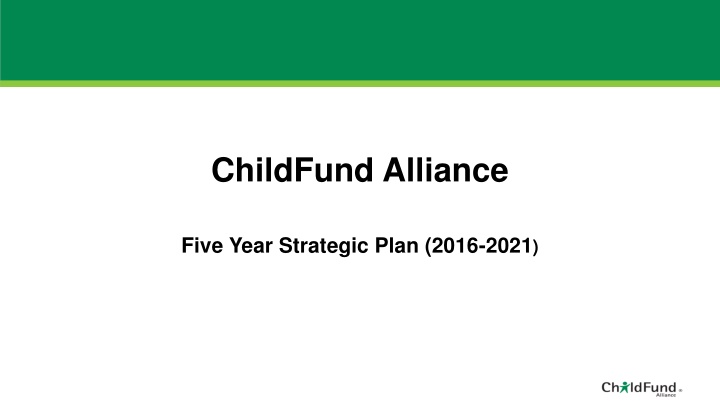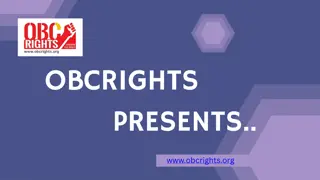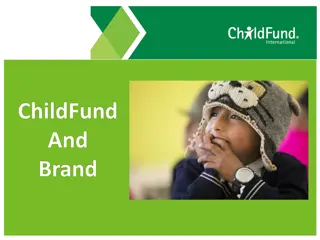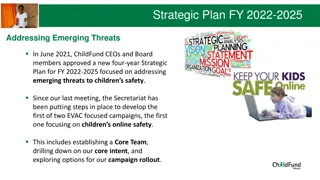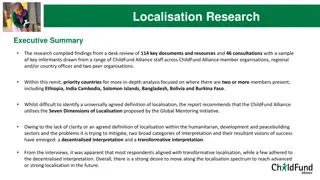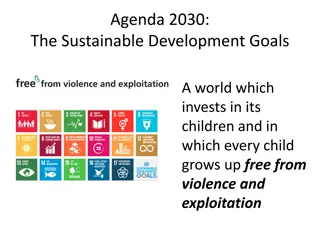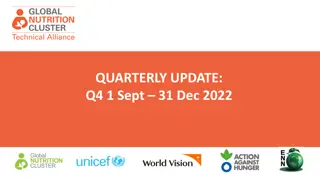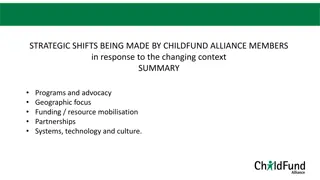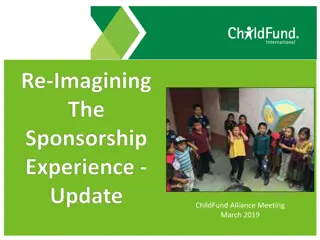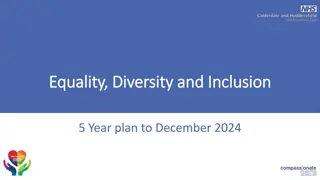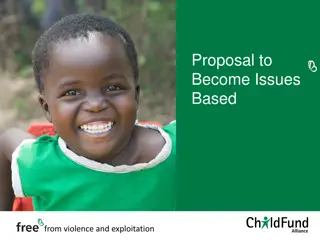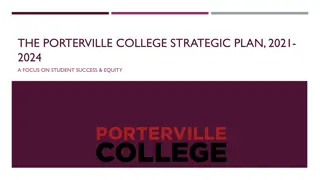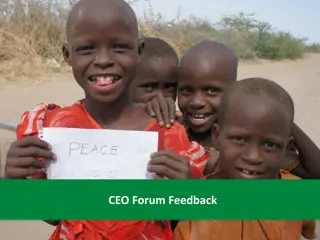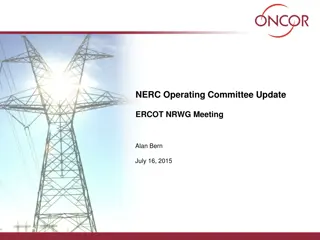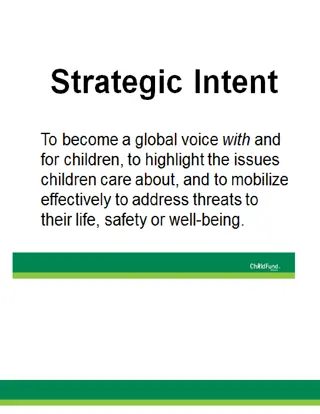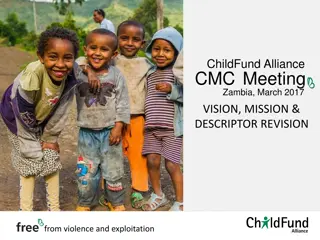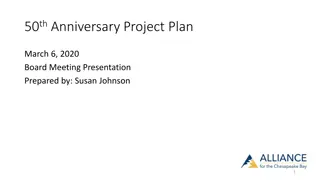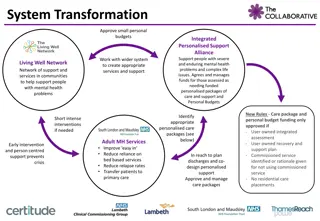ChildFund Alliance Five-Year Strategic Plan (2016-2021)
The ChildFund Alliance Five-Year Strategic Plan (2016-2021) aims to protect children from violence, abuse, and neglect globally. It highlights the economic impact of violence on children and emphasizes the need for prevention. Through perseverance and collective efforts, it advocates for children's rights to a safe and nurturing environment, free from violence and exploitation.
Download Presentation

Please find below an Image/Link to download the presentation.
The content on the website is provided AS IS for your information and personal use only. It may not be sold, licensed, or shared on other websites without obtaining consent from the author.If you encounter any issues during the download, it is possible that the publisher has removed the file from their server.
You are allowed to download the files provided on this website for personal or commercial use, subject to the condition that they are used lawfully. All files are the property of their respective owners.
The content on the website is provided AS IS for your information and personal use only. It may not be sold, licensed, or shared on other websites without obtaining consent from the author.
E N D
Presentation Transcript
ChildFund Alliance Five Year Strategic Plan (2016-2021)
Forward from Secretary General Perseverance is more prevailing than violence, and many things which cannot be overcome when they are taken together, yield themselves up when taken little by little. -- Plutarch
Forward from the Secretary General Children have an inherent and universal right to a life free from violence, abuse, exploitation and neglect as well as a right to survival and development.
Forward from the Secretary General Today, more than one billion children more than half of the world s children are exposed to violence each year.
Introduction The ChildFund Alliance commissioned Overseas Development Institute (ODI) report estimates that the economic impact of the consequences of physical, psychological and sexual violence against children is as high as $7 trillion over a lifetime.
Introduction In 2014, nearly a billion children lived in countries affected by conflict and an estimated 246 million of these children were directly affected by these conflicts.
Introduction Children make up over half of the populations affected by disasters, more than half of all refugees and nearly half of the world s displaced population.
Introduction Humanitarian crises affect a significant proportion of a child s formative years, impacting their survival, growth and development.
Introduction Many who live with violence day in and day out assume that it is an intrinsic part of the human condition. But this is not so. Violence can be prevented. Government, communities and individuals can make a difference. (Nelson Mandela.)
Introduction Violence against children in both humanitarian and non-humanitarian settings is preventable.
Introduction Research shows that: training on parenting skills; helping children to develop socio emotional skills; raising access to health; child protection services; and empowering families economically are among the key interventions proven to reduce of violence against children.
Taking Stock: Key Accomplishments from 2012-2015 Transforming our World: The 2030 Agenda for Sustainable Development was adopted by the United Nations General Assembly in September 2015. All people yearn to live in peaceful and harmonious societies, free from fear and violence. We want to foster peaceful, safe and inclusive societies to ensure equal justice and to protect the human rights of all men, women, boys and girls. (Preamble)
Taking Stock: Key Accomplishments from 2012 to 2015. The 2030 Agenda is a set of 17 universal goals, 169 targets and indicators to frame the global development agenda for the next 15 year. These goals and targets are called the:
Taking Stock: Key Accomplishments from: 2012-2015 In partnership with others, ChildFund Alliance secured a standalone target on Violence against Children: (16.2) End abuse exploitation, trafficking and all forms of violence against and torture of children.
Violence against Children & 16.2 The 2030 Agenda also includes targets related to Violence against Children: * safe and non-violent learning environments (4.a); * eliminate violence, trafficking and sexual exploitation of girls (5.2); * eliminate child marriage, female genital mutilation and harmful practices(5.3) * end the recruitment of child soldiers (8.7) * eliminate the worst forms of child labor (8.7 * provide birth registration (16.9)
Lessons Learned The free from violence and exploitation campaign contributed to making the protection of children from violence and exploitation a global priority within the Sustainable Development Goals plus: Created a stronger ChildFund Alliance; Enhanced capacity across our membership; Increased our visibility with institutional donors and governments; Bolstered our work in collaboration with the largest child-focused agencies; and Improved our access to governments, inter-governmental organizations, academia and the donor community.
Moving Forward Based on its accomplishments, Child Fund Alliance is now well positioned to build on its accomplishments and move forward in this new era for development cooperation. Mindful of the wisdom of the late Nelson Mandela, we must act wisely and work together to create a safer world for children.
Moving Forward: Highlights of the Five-Year Strategic Plan (2016-2021) Our Plan will be guided by the following strategic intent: To become a global voice with and for children, to highlight the issues children care about, and to mobilize effectively to address threats to their lives, safety and well-being.
1. Advance the Achievement of Sustainable Development Goal 16.2 ChildFund Alliance will equip member organizations with the advocacy tools and resources required to mobilize political will and funding for improved policies and programs for children.
Advance the Achievement of the Sustainable Development Goals Establish our advocacy on evidence from proven strategies that prevent and protect child violence. Enhance our global presence as a thought leader on the prevention and protection of violence against children Work with members on an ad hoc basis to customize advocacy asks to national and local contexts.
Advance the Achievement of the Sustainable Development Goals Examples of advocacy asks include: Ensure a targeted budget & allocation of resources to prevent/respond to violence Review an effectively implement legal frameworks to protect children from violence. Endorse and implement the package of proven solutions Positive parenting education School safety Treating victims of violence Working with authorities to enforce laws Fostering norms that protect children
Advance the Achievement of the SDGS Key Performance Indicators: 50% of Members conduct outreach to Member States, relevant regional bodies, UN entities coalitions and others with advocacy requests. Up to 10 priority Member States are identified based on strategic value and targeted in advocacy related to implementation of SDG target 16.2
Advance the Achievement of the Sustainable Development Goals KPIs Relevant program evidence is compiled from 30% of areas where ChildFund is active to serve as the basis for effective joint advocacy.
Advance the Achievement of the SDGs KPIs The Secretariat produces five pieces of research on violence against children. The Secretariat produces five evidence based reports to support work around policy change.
Child Friendly Accountability It is expected that children and youth will have a central role to play in the follow up of goal 16.2 at the local, national, regional and global levels.
Child Friendly Accountability Children and young women and men are critical agents of change and will find in the new goals a platform to channel their infinite capacities for activism into the creation of a better world. Transforming Our World: The 2030 Agenda for Sustainable, the United Nations, 2015.
1. a Engage in Child Friendly Accountability. It is expected that children and youth will have a central role to play in the formulation, implementation and follow-up for SDG 16.2 at the local, national and global levels.
1a. Child Friendly Accountability Child Friendly Accountability is a set of strategic efforts to ensure that the voices of children are meaningfully taken into account in the follow-up and review of The 2030 Agenda.
1a. Child Friendly Accountability Building on our expertise in child participation, the Alliance will develop a child-friendly and participatory methodology to monitor and advocate for the complete implementation of Sustainable Development Goal16.2.
1a Child Friendly Accountability The central goal of Child Friendly Accountability is to work with children in selected countries to hold governments and local leaders accountable to their obligation to end all violence against children as per target 16.2 of the Sustainable Development Goals.
Child Friendly Accountability Objectives 1. To help children access relevant age appropriate data and information an contribute to monitoring violence against children in their schools and communities.
1a Child Friendly Accountability 2. To support children in holding their government and local authorities accountable to their commitments and target 16.2 3. To advocate for international, national and local systems and policies focused on eliminating violence against children.
1a.Child Friendly Accountability Performance Indicators A Child Friendly Methodology is developed to enable monitoring of SDG target 16.2. Five or more national ChildFund programs agree to pilot the Child Friendly Accountability Methodology. National Programs with participating children have developed national action plans
Child Friendly Accountability All Relevant ChildFund Alliance staff have been trained in the Child Friendly Accountability Child Friendly Accountability material regarding the Sustainable Development Goals, child rights, violence against children, national child protection laws and procedures and the methodology have been developed by ChildFund Reporting is established through national processes to the CRC Committee and the High Level Political Forum.
1.b Provide strategic guidance to the Global Partnership to End Violence against Children The newly formed Global Partnership to End Violence against Children offers an opportunity for governments, civil society, the private sector and the philanthropic arena to work together to deliver on SDG 16.2 through three primary channels: Build political will to make violence prevention a priority. Support Path Finder countries to accelerate action to prevent & respond to violence against children Help countries work together to tackle violence against children.
2.Disaster Risk Reduction & Emergency Response Improve our capacity for Disaster Risk Reduction (DRR) and Child Protection Emergency Response (ER). Disaster Risk Reduction Disaster Risk Reduction aims to reduce the damage caused by natural disasters like earthquakes, floods, droughts and cyclones through an ethic of prevention. ChildFund will adapt this concept into a child- and youth-lead Disaster Risk Reduction approach where young people play a safe and meaningful role in their communities with the help of supportive adults in their communities.
Disaster Risk Reduction & Emergency Response Child Protection in Emergencies. Child protection in emergencies is defined as the prevention of and response to abuse, neglect, exploitation, and violence against children in times of emergency caused by natural or manmade disasters, conflicts or other crisis. It involves specific activities by child protection actors, whether national or community-based, and/or by humanitarian staff and others supporting local capacities
Disaster Risk Reduction and Emergency Response Building on its experiences in emergency response to large scale disasters during the last two years, we will strengthen our expertise: Develop local capacity in response to disasters. Focus on preparedness and response to child protection risks in emergencies. Analyze member innovations in Child Protection in Emergencies to highlight key success factors and develop models for replication.
Disaster Risk Reduction & Emergency Response Key Performance Indicators Disaster Risk measures are included in development plans at the community level in 50% of areas where child fund is working. Youth are recognized as key actors in vulnerability and capacity assessments and also in the implementation of Disaster Risk Reduction activities at the community level in 25% of areas where Child Fund is working.
Disaster Risk Reduction & Emergency Response Key Performance Indicators: ChildFund is either directly or indirectly through partners responding to child protection in emergencies needs of children in between 30% of large scale emergencies. Decision on whether or not to respond to sudden onset large scale disaster is made within 72 hours of the event in all cases.
Strategic Priority: #3 Strengthen Membership Strengthen Membership Engagement and Growth To build on its lifesaving work for children, ChildFund Alliance is committed to strengthening and growing our membership.
There are a number of potential benefits to membership growth for Alliance members: Greater Alignment and Scale to bring strategic focus and increased investments for children. Stronger Global Influence by growing the number and diversity of organizations advocating for children.
Membership Growth and Strengthening Efficient use of resources to streamline critical capabilities Improved Collaboration and Knowledge Sharing to facilitate new partnerships and share best practices.
Strengthening and Growing Membership ChildFund Alliance will recruit three new members based on our experience with partners at the field level.
Conclusion World leaders should have in mind that children are the barometer of development. 17 year old boy, Guinea From: Children speak about beingfree from violence and exploitation, ChildFund Alliance 2014
